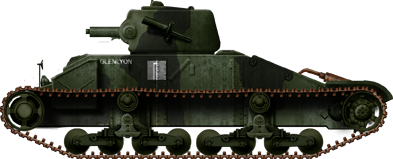The First “infantry tank”

The infantry tank concept was not new in 1935, when this model was planned. This was the main duty of tanks during WW1, to protect, precede or follow infantry in close support assault, in an attrition, fixed position battle. This was the traditional view of the Allies, nearly all officers having fought and learnt during WW1. Generally speaking, the infantry tank was viewed as a relatively small, slow (infantry pace), but heavily armored vehicle, designed to cope with enemy machine-gun nests and lightly fortified positions in a defensive line.

A11E1, the pilot model for the Matilda I series, on trials.
Vickers-Armstrong Conception

The best experienced company then, in terms of tank design and mass production, was Vickers, strong after the fresh success of the Mark E (or Vickers 6-ton). The same team which had worked previously on the Mark E, responded to the imposed specifications. These were very limiting, affected by a costs-cut frenzy. The General Staff wanted a relatively small tank built with as many as possible already available commercial components to reduce conception and manufacturing costs. Vickers quickly presented a prototype which perfectly answered this.
It was a small, two-man vehicle, equipped with a small one-piece cast turret, a straight-cut hull, easy to build, and cheap mechanical components like the Ford V8 car engine, coupled with a Fordson six-speed gearbox, the same steering mechanism as in the Mark E, and a sprung bogie suspension system borrowed from the Mark IV Dragon artillery tractor. To save weight, due to the feeble engine, no protection was fitted for the main drivetrain. There were four big return rollers, and sixteen rubberless roadwheels in all.
Production of the Matilda I
The Matilda I had achieved its main objective and reached the specifications. A first order of 60 machines came in April 1937. Production really started at the beginning of 1938. 80 more were ordered in 1938, when war loomed ahead. In September 1939, the last Matilda I was delivered and placed in operational units. The official name was soon forgotten, in favor of the “Matilda” nickname.
It is said that General Hugh Elles, Master-General of the Ordnance, described his new “toy” as the “Matilda”, according to its unique appearance but the name “Matilda” appeared before the first prototype was even constructed. The Matilda was, in 1939, far from perfect as a tank. Although much better armored compared to contemporary German tanks, it was conceived as a pure infantry tank, and only equipped with a standard issue Vickers watercooled .303 machine-gun (7.7 mm), and later, to improve its armor-piercing capabilities, with the scaled-up .50 inches caliber (12.7 mm) model.
The Matilda I in action

The 140 available Matildas, mostly of later batches, which differed by minor detailing arrangements of the hull, storage boxes, lights, and its machine-gun. Despite its limited capabilities, these tanks were attached to the 1st Army Brigade sent with the BEF, alongside Matilda II tanks. These units fought in the north of France, and the Belgian frontier, around Arras, both in defense on the counter-offensive, even discomfiting the 7th Panzerdivision led by Rommel, a battle in which the Matilda II proved much more effective. Then, the last surviving units covered the perilous evacuation of Dunkirk, before being blow-up to prevent their capture. Others Matilda Is, which were stored in Great Britain, served as training tanks until the end of the war.
The cramped interior and small turret didn’t help the commander, which had to duck down to use the wireless, and direct the driver at the same time. The vulnerability of the tracks and rollers also proved a major issue which was never solved, although the hull and turret had proved immune to the German PaK 37 antitank gun. By 1939 it was aknowledged that this tank was not suited for its intended role, and already replaced by the much better known “Matilda”, in fact the brand-new Matilda II of WW2 fame.

| Matilda Mk.I specifications | |
| Dimensions | 4.85 x 2.28 x 1.86 m (15.91×7.48×6.1 ft) |
| Weight | 11 tons |
| Crew | 2 |
| Propulsion | Ford V8 petrol 70 bhp at 3500 rpm |
| Speed | 8 mph (13 km/h) |
| Range | 80 mi (130 km) |
| Armament | 0.303 or 0.5 in (7.7 or 12.7 mm) heavy machine-gun |
| Armor | From 10 to 60 mm (0.39-2.36 in) |
| Production | 140 in 1938-1939 |

Matilda Mk.I, Infantry tank, Mk.I (A11). The first Matilda was completely overshadowed by the Mark II, a completely different model, although sharing the same name. This designation was originally invented as a nickname for the first, awkward, duck-tail look of the first infantry tank.

Matilda I, 1st Army Tank Brigade, defense of Arras, 15 May 1940. This unit fought against Panzer IIIs and IVs of general Rommel’s 7th Panzer Division. Many surviving Matildas were left in France, most sabotaged, before and during the evacuation of Dunkirk.






Links
About the Matilda I on Wikipedia
About the Vickers .50 heavy machine-gun on Wikipedia

WW2 Tanks




























WW2 tanks posters

All Tiger tanks liveries.

Panther liveries and variants

WW2 Armour - All tanks











Tanks aces and single tanks series

Find more there

Museums, Movies, Books & Games
The Tanks and Armor in pop culture
Tanks and armored vehicles in general are only really grasped when seen first person: The mass, the scale, it's all there. Explore also the way tanks were covered in the movie industry, in books and in video games.Movies:
Best tanks movie on warhistoryonline.com
On imdb.com
On bestsimilar.com/
miltours.com
liveabout.com/
watchmojo.com
Video Games:
pcgamesn.com
historyhit.com
levvvel.com
vg247.com/best-tank-games
mmobomb.com/
alienwarearena.com

